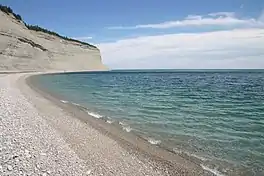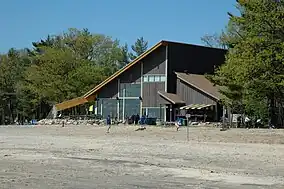National Parks of Quebec
The national parks of Quebec are provincial parks created by the government of Quebec to protect territories representative of natural regions of the province or sites of exceptional character, while making them accessible to the public for education and/or recreation. As of 2023, there are 28 such parks in Quebec, which protect an area of 42,765.57 kilometres (26,573.29 mi), or about 2.8% of the territory of the province.[1][2] All but four parks are administered by the Société des établissements de plein air du Québec (Sépaq). Those four are administered by Nunavik Parks. In addition, Sépaq jointly administers a National Marine Conservation Area with Parks Canada as part of the country's national park system.
Despite the name "national park", the parks on this list are provincial parks, and are not part of Canada's national park system.
History
The first provincial park in Quebec was created on January 12, 1895: Parc de la Montagne-Tremblante was the third provincial park in the country, after Algonquin and Rondeau, both in Ontario, created in 1893 and 1894, respectively.
In order to reinforce the protection in its parks and to respect the criteria of the International Union for Conservation of Nature for protected areas, the government legislated in 1977 with the Parks Act.[3] This divided the parks into two categories: conservation parks, favouring the protection of the natural territory, and recreation parks, which allowed the installation of intensive recreation equipment.
It was from 1999 that the Société des établissements de plein air du Québec (Sépaq) was given the mandate to manage all the parks in Quebec. In 2001, the government changed the status of recreation and conservation parks to one status, that of national parks. The official purpose of the change was to strengthen the conservation component of parks,[3] but it was also a political expression of aspiring Quebec nationalism (see Québécois nation motion. The name change resulted, and continues to result, in confusion for the public.
Area
The size of Quebec's national parks varies depending on whether they are located in southern Quebec, which is densely populated, or in northern Quebec, which is very sparsely populated. Parks in southern Quebec are generally smaller than northern ones.
- 0 at 100 kilometres (62.14 mi): 11 parks
- 100 at 500 kilometres (310.69 mi): 8 parks
- 500 at 1,000 kilometres (621.37 mi): 3 parks
- 1000 at 10,000 kilometres (6,213.71 mi): 3 parks
- 10,000 kilometres (6,213.71 mi) and more: 1 park
Zoning
To meet the conservation objective, a zoning system has been put in place. One of the functions of zoning is to distinguish areas of great fragility and those with good support capacity. The zonings are:
- Reception and service area
- Ambience zone
- Preservation area
- Extreme preservation area
The 'welcome and service area' is, as the name suggests, usually where visitors enter the park. Restrictions on development are less severe than in other areas. This is why there is reception, campsites with services, play areas, sanitary blocks.
The “ambience zone” is the region of a park where it is possible to practice sports which allow the discovery of nature while having a low impact on the environment, such as hiking or snowshoeing. Generally, the facilities are smaller than in the service area.
The 'preservation zone' has a limited support and regeneration capacity and often shelters particular, rare or fragile plant and animal species. The use of the territory is reduced and strongly supervised. Apart from a belvedere, the amenities are non-existent.
The preservation zone extreme is prohibited to all traffic and development. To get there, you must have an authorization from the park director and have a scientific purpose. There are often rare species there that are sensitive to disturbance.

The protection of certain fragile or exceptional ecosystems is done through strict regulations. Logging, mining, petroleum and energy exploitation as well as hunting and trapping are strictly prohibited. On the other hand, the practice of outdoor sports such as mountain walking, snowshoeing, canoeing or biking are accepted and fall within the mandate of discovering the parks. Several other natural environment interpretation activities are offered and the many naturalist guides present are there to answer your questions. Since 1999, the management of the activities and services of these environments has been entrusted to the Société des établissements de plein air du Québec (SÉPAQ). In addition, the parks north of the 55th parallel are managed by the Kativik Regional Government.
In 2001, Quebec's parks became national parks. The designation 'national' indicates that the parks comply with standards established by the International Union for Conservation of Nature (IUCN). According to IUCN, a national park is a protected area managed primarily for the protection of ecosystem and for recreational purposes.
List of national parks in Quebec
National park reserve
In addition to the national parks, the ministry has also designated certain areas as national park reserves. Although they are protected areas, these territories do not have the same legal protection as that of the parks.[12] They are located exclusively in Nord-du-Québec. In other parts of Quebec, the ministry prefers to designate similar areas as biodiversity reserves.
| National park reserve | Area km² |
Storage | MRC |
|---|---|---|---|
| Assinica | 3,193.00 | 2011 | Jamésie |
| Baie-aux-Feuilles | 3,868.10 | 2008 | Kativik |
| Collines-Ondulées | 1,659.50 | 2008 | Kativik |
| Iluiliq | 1,263.00 | Kativik | |
| Monts-de-Puvirnituq | 3,159.00 | Kativik |
National park projects
Research will be carried out with a view to acquiring knowledge concerning two other projects in Nunavik, namely:
- from Cape Wolstenholme,
- from Baie-aux-Feuilles.
The creation of two parks is also being considered in boreal forest, in partnership with the Cree. These are national park projects:
- Nibiischii (formerly titled Albanel-Témiscamie-Otish),
- Assinica.
The Ministère de l'Environnement et de la Lutte contre les changements climatiques (Ministry of Sustainable Development, Environment and Parks of Quebec) has also undertaken preliminary studies concerning other national park projects:
- Harrington-Harbour,
- Natashquan-Aguanus-Kenamu.
Public consultations were also held for the expansion of Mont-Orford National Park and Pointe-Taillon National Park.
See also
- Protected areas of Quebec
- List of protected areas of Quebec
- Zone d'exploitation contrôlée (Controlled Harvesting Zone) (ZEC)
Notes and references
- "Québec national parks network". Ministry of Forests, Wildlife and Parks. Retrieved June 21, 2023.
- Based on Quebec's de facto total area of 1,542,056 kilometres (958,189.18 mi).
- "The Parks Actes". Ministry of Sustainable Development, Environment and Parks. Retrieved August 28, 2009.
- Is included in the IBA Monts Chic-Chocs
- Central area of the Charlevoix Biosphere Reserve and is part of the ZICO Charlevoix
- Park created following the split of Laurentides Wildlife Reserve
- Central area of the Charlevoix Biosphere Reserve
- Includes the Île Bonaventure IBA and straddles the Île-Bonaventure-et-du-Rocher-Percé National Park
- Site of World Heritage of Miguasha National Park
- Includes ZICO Mont Mégantic
- Includes the ZICO Réserve faunique de Plaisance
- Ministry of Sustainable Development, Environment and Parks. "National park reserves". Retrieved October 8, 2008.
Further reading
- Benoit Limoges (2018). "The socio-cultural and monetary values of the ecological services provided by the national parks of Quebec". Le Naturaliste Canadien (in French). 142 (1): 36–49. doi:10.7202/1042012ar.
- Marie-Ève Deshaies; René Charest (2018). "La conservation des parcs nationaux au-delà de leurs frontières" [The conservation of national parks beyond their borders]. Le Naturaliste Canadien (in French). 142 (1): 50–63. doi:10.7202/1042013ar.
External links
- Official site of Parcs Québec, affiliated with SEPAQ
- "National Parks". Ministry of Forests, Wildlife and Parks.
- "Parcs Nunavik". (Manager of the Pingualuit, Kuururjuaq and Tursujuq national parks)




.JPG.webp)


.JPG.webp)














.jpg.webp)
